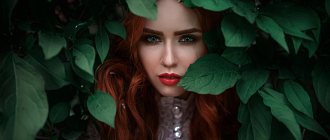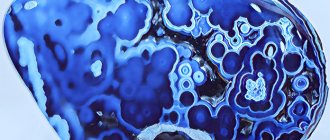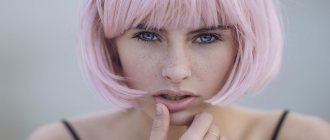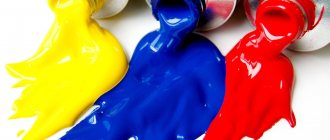Green color and physiological processes
Green is called neutral. Having a wavelength from 500 to 560 nm, this color does not cause excitement, like red, but also does not have an inhibitory effect on physiological and mental processes, like blue or cyan.
It would seem that green should not affect the condition of our body at all. However, we exist among a variety of numerous shades, and the effect of green is perceived by contrast:
- it calms the psyche, tired of red and orange energy;
- invigorates after cold blue and blue colors.
Studies by physiologists and psychologists have shown that green has a good effect on an overexcited body:
- calms the nervous system;
- normalizes blood pressure, pulse and breathing;
- has a beneficial effect on blood vessels, relieving their spasm.
In psychotherapy and psychiatry, green is used not only to calm the nervous system, but also to treat claustrophobia.
This color miraculously removes the negative manifestations of the disease if the walls of a confined space are painted with it.
- I. Goethe, in his work “The Doctrine of Color,” spoke of green with tenderness, saying that it brings satisfaction and rest to the soul.
- But the artist V. Kandinsky, who also paid a lot of attention to the study of color, noted passivity and lack of movement in green.
Kandinsky lived and worked in the “red” society of post-revolutionary Russia and the color green seemed boring to him.
Green color and emotions
The influence of green on the human psyche can be described in two words: calms and tones. It is this slightly contradictory effect that makes green an optimal performance stimulant.
It prepares a person not for an explosive, powerful, but short-term effort, like red, but for long, calm and even monotonous activities.
Low energy levels make green not only calming, but also boring. And the more cold (blue-blue) shades the green color that surrounds us absorbs, the more boredom and less joy it contains. It’s not for nothing that there is such an expression: “green melancholy.”
V. Kandinsky, for example, compared green with a bourgeois swamp, considering it a symbol of complacent, passive nature.
But green with a hint of yellow is the color of young spring grass, truly positive, invigorating and refreshing.
Designers often choose this color to decorate the interiors of work spaces, but as soon as they “miss” a little with the shade, instead of a positive business mood, the color of the surrounding space begins to cause boredom and melancholy.
Even if a person is not in love with the color green, he rarely experiences truly negative feelings towards it.
But this still happens. This color is rejected by people who feel pressure from society and want to get rid of it. Those who want privacy in passive idleness are also annoyed by green, and overly active and aggressive people treat it with contempt.
Green symbols of modernity
Like most other shades, the symbolism of green in the modern world is diverse and contradictory. The whole point is that ancient, primordial symbols born in myths in the consciousness of society calmly coexist with religious traditions and modern symbolic meanings.
- The most common meaning of green is the ancient symbols of youth and the rebirth of life. They are characteristic of almost all cultures of the West and East.
- This color is a symbol not only of youth, but also of inexperience. (“Green still!”) But it is also a symbol of growth, including career growth.
- This color is a symbol of nature in all its manifestations; it is not for nothing that defenders of our natural environment are called “green”.
- Green is considered a symbol of good luck and material wealth, perhaps associated with paper dollar bills.
- In Islam, green is the sacred color of the banner of Islam.
- In medieval Europe, negative symbolism of this color was formed. It was considered a symbol of deceit, temptation, and a “devilish” color. Perhaps this is due to his veneration in pagan cults.
And to this day, green is often associated with evil spirits: green devils, green eyes of true witches, elves like to dress in green outfits, etc.
- And at the same time, green is considered the color of wisdom and comprehension of the secrets of the Universe.
Despite the controversial symbolism of this color, green is readily used in interior design and website design, because it creates a favorable atmosphere for fruitful activities and creativity.
Everything about the rules for choosing the color of furniture, interior design and the psychology of colors on the human body
Color therapy is an ancient science. It appeared in the IV-III millennium BC. The founders of color therapy were China and India. This science was highly valued by famous scientists of that time - Avicenna, Hippocrates, Paracelsus. Colors were prescribed to treat various ailments. Doctors recommended covering windows with curtains of a certain color and taking baths with colored water. Wearing colored clothes also produced the desired effect.
Today, these color therapy techniques have been preserved. You can use different colors to organize the interior of the room, use shades in clothes and surrounding objects. If you choose colors wisely, you are guaranteed success in life.
Color combinations. Contrasting are 2 colors that are opposite each other. Related - located in the same color sector. The sector is located in the sector between the primary colors: red - yellow, yellow-green, green-blue, blue-red. There are 4 sectors in total. Related-contrasting - colors from two adjacent sectors
Psychologists talk about the different effects of color on people. Do not neglect the advice when choosing furniture for yourself and your loved ones. The choice of color in the interior of your home largely determines the atmosphere that will reign in it. Therefore, it is important to make an informed choice of colors. First of all, the color in the interior should be in harmony with the inner world of the household. Chromotherapy is the therapeutic effect of color on the body. It is used to prevent and treat diseases and stressful conditions, such as sleep disorders, headaches, chronic fatigue syndrome, nervous disorders, musculoskeletal diseases, respiratory organs, digestive organs, heart and blood vessels, joints, etc.
In many ways, the color of the interior depends on the taste and personal preferences of the home owner. Every person eventually faces the solution to a similar problem. Lately, people have begun to think about the impact of the chosen color on their mood and even their well-being. Each color has a specific effect on the subconscious, as well as on the physical and emotional state. The duration and intensity of exposure to certain colors have specific meanings. Some colors can evoke positive emotions, others negative. There is an opinion that women are more sensitive to color and its shades than men .
The second point that is important to consider is the psychology of color. Therefore, it is important to know exactly what influence is typical for each of the basic colors.
And, the third point that is important to say is that the choice of color depends on the nature and purpose of the rooms in your home. Warm, active colors are perfect for the kitchen, dining room, living room, but for our places of relaxation and rest we need calmer and muted tones.
Here are some simple tips:
- melancholic introvert - furniture in warm colors (yellow, coral pink, scarlet, orange). Such tones will help you improve your performance and activate the capabilities of your body;
- extrovert - you better choose tones that can bring calm: blue, green, indigo;
- optimist your color is pink.
By the way, experts say that this color can slow down the aging process, but you shouldn’t overdo it, otherwise you might fall back into childhood. White color in the interior. - In Western culture, white is associated with purity and elegance. It’s not for nothing that this is the color of weddings, celebrations, and angels. White color in the interior can open up the space and let in more light and air. However, an excessive amount of it can make the interior lifeless and boring. Its incorrect use can cause unpleasant associations - with hospital wards and sterility. Therefore, the white color must be “softened” using various shades (baked milk, ivory, etc.). As well as different textures on walls, textiles and floor coverings. This will help make a white room warmer and more attractive - both perceptually and physically. White color symbolizes cleanliness, health, freshness, cheerfulness and lightness. Due to this color, you can increase the illumination of the room, but also visually increase the space. White color is successfully used in a small space to enhance the lighting of the room. It is also used as an excellent background for bright interior elements. The white color scheme inspires, invigorates, encourages action, however, it should not be used in large quantities in bedrooms. An excess of white color negatively affects intimate relationships.
Psychologically, white color helps relieve tension, free yourself from annoying thoughts, concentrate, discard everything unnecessary and make the right decision.
Black color in the interior.
- The most commonly used color is black. It is versatile and goes well with other colors.
- If there is a lack of lighting, do not overuse black. This color goes well with mirror surfaces. Although black symbolizes emptiness and denial, it is still among the most sought-after colors not only on the world's fashion catwalks, but also among famous furniture manufacturers. Design experts recommend its use in bedrooms.
The correct use of black in the interior can emphasize the atmosphere of sophistication and elegance. It will perfectly highlight details against a background of light or neutral colors, highlight architectural nuances, pieces of furniture and decor.
Black is often used to convey an air of power, authority and social prestige (think black Mercedes, black tuxedo).
- However, be careful and use it very sparingly. Otherwise, he can create a threatening, dark, oppressive environment. Constant exposure to the color black can negatively affect a person’s psyche, suppress him, and create a feeling of depression and hopelessness.
- Even if you find yourself in a difficult life situation and you are involuntarily drawn to black colors, take a step to the side and reduce the amount of it in your life.
- It is perceived by us as difficult and can set a person up for melancholy and despondency, lead him into loneliness and isolate him from the outside world. These are the disadvantages of black.
- Among the advantages, the following can be highlighted: this color allows you to focus on spiritual ideals; with its help, you can isolate yourself from external hustle and bustle and concentrate on solving complex problems or internal crises. Black is very elegant and sexy and at the same time it looks businesslike and serious. It is believed that black color has sophistication and culture, it seems to be opposed to the whole range of vulgar colors
- For children, black color is categorically contraindicated - children, even in adolescence, are very delicate and impressionable natures. Therefore, there is no need to deprive them of the colors of life and normal living emotions, even if your child follows some fashionable musical trend and insists on a dark interior.
- Brown color in the interior.
- Shades of brown evoke associations of comfort, home, and warmth. Brown color is perfect for the element Earth and the primary element Wood. After all, nature is full of brown.
This is why the psychological impact of the color brown is often described as reassuring, creating a feeling of security, stability, groundedness, solidity, common sense.
- A large amount of brown in the interior helps to make calm, informed decisions.
- Brown is wonderful for the interiors of those people who, due to their occupation, are forced to spend a lot of time in bright, colorful places or constantly move around and meet a lot of people. This color in the interior is also suitable for those who work or relax in places with loud music, multi-colored decoration, and illumination.
- Psychologists note that brown color is often chosen by people in need of psychological relaxation and detachment from bustle and worries. Those who are in search of ways to express themselves, their own style and something they like, reject brown. Thus, the predominance of brown in the interior can be recommended to accomplished, self-sufficient, self-confident people.
- In interior design, brown can add warmth and depth. It can warm up cool or neutral color combinations and make a room feel more comfortable and cozy.
The neutral color that best suits cabinet furniture is brown. Light tones of this color are ideal for kitchen or bedroom interiors.
- Brown color has a calming effect that adds strength; it creates the impression of perseverance and good quality, freeing up the flight of imagination. According to some beliefs, this color can have a beneficial effect on your financial situation.
Gray color in the interior.
- The correct use of gray in the interior can give an elegant rigor, which at the same time will not be boring and conservative. Use it if you want to create an atmosphere of calm, reliability and trust. This works best when paired with white and other neutral tones.
Gray color in the interior can be an excellent background for other, more intense colors. If you choose the right shade of gray and use it with bright colors such as pink, fuchsia, turquoise, or orange, it will unify and harmonize the overall look.
The danger with using gray is that if the color covers too many surfaces without combining with other colors and bright accents, it can create a dull, dull and even ominous atmosphere.
A gray background can serve as a wonderful backdrop for luxury items. It is believed that this color can help relieve stress by being practical and calm.
Red color in the interior.
- Red is an extremely powerful color. As with other colors, the psychological effect of red depends greatly on its intensity. It has been established that bright shades of red cause a person to have a rapid heartbeat and increase blood pressure. But you can feel quite comfortable among muted, warm brownish shades of red.
The color red is also associated with danger (think fire, brake lights). But it is also the color of action. Do not overuse red in the interior. It visually brings the walls closer and narrows the space. But as an accent or even the color of one of the walls, it can be very effective if you want to give the atmosphere a mood of cheerfulness, encouraging action and activity.
Red color in the interior should be used in rooms where you meet with friends, spend time actively and should be avoided in places where you need rest and relaxation.
Shades of red emphasize luxury, wealth and beauty. This color is believed to induce positivity. Designers recommend using red tones when decorating the interior of a kitchen, hall or living room. Care should be taken when using this color for children's rooms and bedrooms. In this case, you should choose the right shades.
- Shades of red create a feeling of joy, fun, activate the subconscious, helping to raise a person’s vitality, and stimulate his determination.
- It is assumed that it has a healing effect, has a beneficial effect on the functioning of the liver, kidneys and circulatory system. In addition, the color red increases sexual activity in people.
Orange color in the interior
- Orange is the warmest color. It is perceived as emotionally stimulating, energetic, lively and fun.
Rich orange attracts attention and stimulates the appetite. That is why it is often used in advertising, cafe and restaurant interiors. The effect of orange depends on its intensity (it can be more yellow or more red) and its hue (dark, neutral or light).
- Orange has its greatest impact in its pure form, when it is not lightened, darkened or mixed with other colors. It becomes softer in its pastel and earthy shades.
- The yellow-orange robes of Asian monks evoke feelings of spirituality and tranquility. On the other hand, in Mediterranean style, orange is mixed with brown tones to create different shades of terracotta. These shades convey the warmth and richness of southern countries.
Orange color in the interior can energize, uplift, invigorate, inspire confidence, evoke positive feelings and joyful emotions. Therefore, it should be used in those rooms where you want to feel exactly this state.
Orange shades of color encourage communication and create an atmosphere of harmony. Orange color has a relaxing effect not only on the emotional, but also on the physical level.
- Orange tones are used by designers for living rooms and kitchens, since it is in these rooms that family members most often communicate.
- It is most appropriate to use these tones in a room that is reserved for a child’s activities, since the orange color promotes fruitful mental activity, increased energy and mood, and is conducive to work.
- The color symbolizes joy and activity. Has a beneficial effect on the functioning of internal organs. Green color in the interior
- A lot can be said about the benefits of green, but its main property is its positive effect on the eyes. Unlike other colors in the spectrum, green is perceived by the eye without distortion. Green color in the interior is associated with wildlife, herbs and trees. Perhaps that’s why it helps you relax, calms you down, and brings pleasant thoughts to your mind. This color in the interior is ideal for meditation, and just relaxation after a busy day at work. Green color has a calming effect, rejecting bad energy and negative emotions. This color can be safely used when designing the interior of a bedroom or children's room. This color has concentrating abilities that help achieve good results in work. For this reason, work rooms are often designed in these colors. Green is rightfully considered a symbol of movement and growth; it helps to calm down and find self-confidence. It has antiseptic properties and has a positive effect on the growth and strength of muscle tissue.
- Yellow color in the interior
- Yellow is rightfully considered the “warmest”. It is recommended to use this color in the interior of rooms located in buildings on the north side. It is believed that warm yellow tones have a positive effect on the liver and digestive organs, increasing appetite. Sunny color is the color of optimists; it helps in achieving the desired result. Symbolizes intellectualism. Positively affects the nervous system and skin.
Psychologists say that yellow is the happiest color of the spectrum; it inspires optimism and joy. The abundance of yellow in the interior can quickly tire you.
- Yellow is the brightest, warmest and most cheerful color for a children's room. Children love him very much! It simulates activity well, sociability, and helps maintain physical tone, and this is exactly what children need for full development.
- Taking into account the influence of yellow on intellectual functions, use it to decorate your study space. In combination with red, it can increase the thirst for knowledge and push the child to learn something new. This color is not suitable for the bedroom; it is overly bright and stimulating and will not give you the opportunity to properly relax.
Blue color in the interior.
- For many people, blue is their favorite color.
In the interior, you can use blue to create an intellectual atmosphere that brings clarity to thoughts. It is practically impossible to feel increased aggression, emotionality or overexcitement while in a cold blue environment. The color blue lowers our blood pressure and heart rate.
- It can also symbolize kindness, fidelity, constancy, favor, and in heraldry it denotes chastity, honesty, good reputation and fidelity.
- You can use blue in your interiors to cool down hot, sunny rooms. Obviously, blue color will not lower the temperature physically, but psychologically we will feel cooler. The opposite is also true; if you add blue to north-facing rooms, the space can take on a chilling tone.
The wide range of shades of blue affects us in different ways. Blue - brings peace and tranquility, allows you to understand yourself, turquoise - stimulates performance, helps increase our self-esteem, and relieves stress. Indigo is a rich, deep blue associated with intuition and understanding.
- The color blue also conveys a sense of trust, which is why it is often used in advertising for banks and other financial institutions. Light blue is a combination of blue and white, so it combines the effects of both colors. One part of it helps you relax and calm down. It creates a cool and refreshing effect. The second part stimulates the imagination and promotes attentiveness. Blue color is often found in school classrooms and office spaces. Blue is also good in the office, in the room where controversial issues are resolved and conflict situations are frequent.
- In combination with yellow and red, blue is suitable for decorating children's rooms. It contains a playful element, we can also combine it with pink, light green, ocher, orange, lilac and other colors that will make the baby’s room cheerful.
Using delicate shades of blue and blue in the interior is most useful. An atmosphere of calm is created, allowing you to relax and calm down.
- Most often, these colors are used in design projects for bedrooms. Desaturated and fresh tones are used here.
- Blue and cyan colors have a negative impact on appetite, so their use should be meaningful. But those who want to lose weight can use it to their advantage: the color of the walls, tablecloths or dishes will help in this case to reduce their appetite.
- It is believed that such colors contribute to the development of intuition. “Blue blood” has always been considered a sign of nobility, so it is not surprising that the color itself symbolizes spiritual nobility.
- Some scientists believe that the color blue helps in the treatment of deafness, cataracts, bleeding and insomnia. It has calming properties that constrict blood vessels, having a positive effect on sleep.
Purple color in the interior.
- Purple color is quite complex both in terms of perception and in terms of its origin. In the west, purple is the color of royalty. The Roman Emperor Julius Caesar decided that he would be the only person allowed to wear purple.
When it comes to interiors, purple can be that rich and complex color that brings true luxury to a room. On the other hand, there is a danger that purple in the interior in its wrong combination and shades can look bright and cheap.
The psychological effects of purple depend on the “warm” or “cool” shades you use. Violet with blue notes can have a calming effect and impart a mystical depth. Reddish purple is likely to dominate the room, so it should be used with caution. In general, it is better to give preference to light shades, since deep dark colors can cause nervous tension and even psychological instability.
Violet tones are most often chosen by people who are inclined to philosophy. This color is considered one of the most mysterious. Purple has a beneficial effect on the formation of mental flow and observation.
- True, designers do not recommend focusing on this color. Do not forget that dark shades of purple are a little tiring. Although this color symbolizes mental abilities, the use of this color in the interior of residential premises should be minimized. It harmonizes with many other colors.
- Violet tones help reduce pain and temperature, relieve migraines, insomnia and depression, restore and strengthen the nervous system, and bring calm.
- Typically, little girls prefer lavender, especially when combined with pink. Lavender is Barbie's favorite color, so don't expect boys to want to live in a similar atmosphere either!
- Pink color in the interior.
- Pink color has a very wide palette of shades. The color pink creates an atmosphere of tenderness, softness and care. It symbolizes femininity, happiness, positivity. We often associate the color pink in the interior with a girl’s children’s room. However, there are many exquisite shades of pink that famous designers use in their work for both men and women.
The psychological effect of the color pink is that it calms, relaxes and softens us. Pink tones have an amazing property: they neutralize the aggressiveness hidden in many of us and provoke friendliness. Its violet (red-violet) hue indicates that it is most often chosen by people who do not recognize slavery (their motto is freedom in everything). It allows us to focus on the inner world, makes us more sensitive and sentimental. Therefore, if you are a very sensitive person, it is better for you to avoid it, so as not to aggravate this quality, but to compensate for it with those colors that will give you determination and bring you back to earth.
- Pink color – symbolizes romance, kindness, love and passion. He is fueled by an aura of innocence and purity.
Pink is a mixture of white and red. Tenderness, masculinity, lightness, inspiration, strength, stability and self-love “live” in this color.
- Pink tones help in times of crisis. Often, interior elements in pink shades are used for meditation, as they can evoke a feeling of security and happiness, while increasing the overall immunity of the body. And doctors say that shades of pink help with insomnia, promote peace and reduce blood pressure.
- There are methods for arranging flowers depending on the purpose of the room. For example, a bedroom or study is not a place for rich colors. If you create wide, monochromatic spaces, the color will act depressingly. Contrast is not the best solution for break rooms and work areas. Incredible acid combinations used to be all the rage. But experience with the use of contrasts has shown that they contribute to the development of nervous disorders. It is possible that bright combinations will be appropriate at a disco, but it is better not to use them at home.
- Adding other color accents to the main color of the interior will make the room more interesting and pleasing to the eye. So, the main color of the interior is green. Additional colors: blue, light green, yellow, lime, black. The main interior color is blue. Additional colors: gold, turquoise, silver, white, red. The main interior color is red. Additional colors: pink, white, silver, orange, gold, black, blue.
- The energy of color is the shortest path to harmony and success. If you use color therapy techniques, your life will soon change for the better.
You can consider several methods of how colors affect a person:
- ACCENTS. Some colors have a strong effect; if they are in excess, the effect can be negative. Therefore, you should not completely stick to one color. For example, small red wardrobe items will have a positive effect on vital energy. You can use multi-colored pillows in the room, arranging them according to the method. Then the energy will spread throughout the room.
- LAMPS: The light from lamps can be not only white. Bright lampshades will fill the room with the right color.
- DECORATIVE STONES: The color of the stone affects your health and emotional state. Colorful minerals on the shelves will not only be a pleasant addition to the interior.
- FLOWERS: Beautiful flowers have a similar effect. Bouquets can be made in the same color scheme, or you can use different colors.
- LIGHT: In the theater, special filters are often used that change the light of the lamps. Use them in your interior.
- FOOD: Creating dishes from colorful foods is taking care of your digestion.
BRIGHT WINDOWS: Stained glass is a well-known decorative technique that has been around for many years. Today, a similar rainbow can be created using stickers.
The meaning of green in psychology
The green color comes from chlorophyll, a pigment that is part of the structure of the stems and leaves of many plants. Thanks to this substance, plants independently provide themselves with nutritional pigments.
This process is called photosynthesis, and chlorophyll plays a major role in it.
Green is considered a primary color, like red, blue and yellow, so it can be used to create a huge number of other colors.
List of popular shades of green:
- light green;
- turquoise;
- olive;
- chartreuse;
- aquamarine.
Interesting information about the color green
- An English study confirmed that MarrsGreen is considered the most attractive color. It is a neutral shade of green mixed with blue.
- In Orthodox Christianity, green symbolizes endless life.
- In Islam, green is considered sacred and represents life and Heaven. Because of this, it often adorns the flags of Muslim countries.
- Symbolizes Ireland and St. Patrick's Day. The leprechaun is a popular Irish folklore character and one of the symbols of this state, dressed in green clothes. The green clover leaf also symbolizes Ireland.
What does it symbolize?
Our ancestors also identified this color with certain factors:
- joy;
- happiness;
- youth;
- childhood;
- warmth;
- carelessness;
- wealth;
- calm;
- balance;
- hope;
- wisdom;
- height;
- development.
It often symbolized the harvest, farming and gardening.
Today it is difficult to identify this color with some kind of negative. It is difficult to imagine that in some regions green was associated with evil spirits:
- demon;
- devil;
- sorcerer;
- various evil spirits.
It is because of this that some believe that green-eyed women have superpowers.
What associations does it evoke?
- Most people associate green with plants, leaves of trees and flowers, berries, vegetables and fruits (lime, cucumber, avocado, apples).
- Some reptiles and birds are also green in color. Many people associate this color with frogs, lizards, snakes, toads, crocodiles or monitor lizards.
- Parrots, bee-eaters, organists and some varieties of pigeons have beautiful green plumage.
Psychology has different attitudes towards the color green. For example, the light green color has a certain connection with yellow, so it is endowed with some of its properties.
If there is little green in the light green one, this will give it coldness and softness. This combination has a positive effect on people and calms them down.
Psychologists attribute positive qualities to color. Even dark shades practically do not cause negativity, since they are closely associated with nature.
Health
- Has a positive effect on people with claustrophobia.
- Helps get rid of negative emotions and relieve tension. If you admire green objects for a short time.
- If a person suffers from insomnia, this color will help you relax and fall asleep faster.
- If you have difficulty making certain decisions, you can surround yourself with green things. For example, in the summer, just go for a walk in the park.
- If a person has vision problems, a tendency to depression, liver or heart disease, green objects will help. It also helps relieve headaches and lower blood pressure.
Why is it used in advertising?
Green is often present in organic and food commercials because we perceive it as a symbol of freshness, naturalness and closeness to nature.
Numerous stickers with the words “bio” and “eco” also have green details.
Since packaging must display the contents, green is often used to create packaging that sells vegetables and fruits of the same color.
This color and its various shades can be found in advertising for pharmaceuticals, private clinics (even veterinary ones) and pharmacies. This is due to the fact that for many, green signifies health and youth.
Cloth
- The color green predominates in clothing when a person wants to impress someone.
- It is believed that outfits of this color and its shades help to demonstrate firmness, constancy, certainty, and sometimes toughness.
- Wearing green items can improve your self-esteem and confidence.
- If a person prefers green outfits, he wants to please everyone or strives to be recognized by society, needs everyone's attention.
- Those individuals who dress up in green do not like competition; they are afraid of the possibility of being influenced by someone strong. Such persons want to assert themselves.
How does it affect the psyche?
It has been proven that shades of green have different effects on our well-being. In general, green is a calming, relaxing color, but bright shades can uplift and energize a person.
Impact of green color on humans:
Its positive effect on male and female bodies has been proven. With its help you can get rid of phobias, depression, anxiety disorders or neuroses. It increases stress resistance and calms people with an aggressive and hot-tempered character. It energizes tired people, lifts their mood, helps them concentrate and improve their performance.
In a room with neutral green walls, a person falls asleep easily and quickly, and his sleep is very pleasant.
- It has been experimentally proven that when being in a room with a green interior, a person feels warmth, comfort and coziness. Even a few objects of this color can improve the well-being of a person staying in this room.
- Helps to free oneself from negativity and soften the manifestation of emotional swings in people suffering from psychological problems.
- Color therapists claim that it reduces pain, stimulates the treatment of infectious pathologies, stabilizes pressure in the arteries and cardiac function, lowers temperature, and has a positive effect on the functionality of many organs and systems.
The greatest influence of this color is observed on the visual organs, musculoskeletal system, muscular system, gastrointestinal tract, pituitary gland, and respiratory system.
It has a positive effect on the development of romantic relationships, making partners reasonable and attentive to the demands of their other half.
Features of color therapy
Color therapy, or chromotherapy, is used to correct mental conditions and treat disorders. Subconsciously, every person resorts to this technology when choosing a wardrobe or interior. But the professional use of psychotherapy helps reduce anxiety, get rid of depression, increase self-confidence and improve overall quality of life.
The specificity of the influence of color depends on its wavelength. Short and long waves affect different parts of the brain.
Long-wave warm shades invigorate, short-wave (cold) shades inhibit mental activity.
Color therapy is the most accessible method of psychological correction. Knowing how color affects a person’s emotional state and well-being, you can independently apply this in practice. For example, choose a wardrobe that matches your energy, change the curtains in the house, buy colored bath bombs. A combination of color therapy and art therapy will have a special effect.
Pulled to green: what could this mean?
- Approximately 15 percent of people in European countries find green very attractive. The same number of people do not like this color and consider it magical.
- Scientists have proven that there is some connection between color preference and human character. This information can be taken into account when meeting a new person.
- But there is no need to take the “color” characteristic too seriously: we are all unique individuals and there is no need to build relationships only on the average description of character.
A man who likes this color most often has:
- Balance. It is difficult to anger such a person. He will be calm in almost any situation. He is extremely rarely aggressive and hot-tempered.
- Good nature. He is a kind, bright person who loves to help others. There is always a sincere smile on his face.
- The desire to care. Such a man will be a good husband and father. He protects his loved ones and does everything for their happiness.
- Sociability. Of course, he is not such an ardent lover of conversation as a connoisseur of yellow or red colors. A man loves communication in good company and in most cases evokes positive emotions in his interlocutors.
- Optimism. He experiences all adversity with a smile, and can even be self-ironic. This helps him to be calm and balanced.
For a woman who chooses green, family and close people come first. Work and career are secondary for her.
Such a woman is very friendly, loves to meet people, has good mental and physical health, and loves to lead an active lifestyle.
Color perception - how does it function?
Color perception is one of the functions of vision, thanks to which a person perceives the world in all its variety of colors and shades. The refractive system of the eye and the retina, on which light rays are collected after refraction by the lens and cornea, are responsible for image formation. The color of the picture is determined by the central point of the retina - the macula, or more precisely, the cones. These photoreceptors provide color vision and are involved in photopic (daytime) vision.
There are three primary colors in nature: red, green, blue. The entire variety of shades, of which there are several tens of thousands, is formed by mixing these three main tones. This theory was put forward by Lomonosov in 1756. T. Jung conducted his research in the same direction. Subsequently, the idea of three-component color perception was supplemented by G. Helmholtz and his students. There are three types of cones, each containing a specific pigment. In other words, the macula contains blue, red and green cones. In this case, color waves, regardless of their length (spectrum), immediately affect the entire cone apparatus. If there are any defects in it, the color perception will be incorrect. In this case, we are talking about color vision disorders. They are caused by pathologies of the optic nerve, retina, and nervous system.
Color vision disorders are rare. Approximately 8% of all men have congenital impairments of this visual function, but this does not mean that they cannot distinguish colors at all. In most cases, one of the spectra is not available to them. In women, problems with color perception are even less common (approximately 0.5% of cases). Color vision disorders can create some difficulties when choosing an activity. Information is often presented in the form of color signals - in transport, industry, agriculture and other areas.
Who is it suitable for?
Green is a universal color. If you choose the right colors, you will look good in it at a party or business meeting.
But experts advise not to wear light-colored clothes to important meetings: others will perceive you as a frivolous person.
In the interior, green should be used by people who value comfort and coziness. The bedroom can be decorated with neutral shades.
Cons of green
The meaning of green in psychology also has negative aspects. People who prefer this color have:
- excessive craving for stability;
- conservative views;
- selfishness;
- jealousy.
Some people succumb to the calming effect of color so much that over time they become passive and indifferent to the world around them.
Green is a mysterious color, so it can make its fans overly hidden, which is not always a good thing. Due to this property, color is used by psychologists to treat claustrophobia.
Staying in a closed green room, a person begins to calm down and get rid of the phobia.
Color can be harmful to people with nervous exhaustion.
Negative impact
Can the color green harm the human psyche? This shade is not suitable for those who are different:
- increased anxiety;
- isolation;
- the desire not to attract everyone's attention;
- inability to overcome difficulties and obstacles.
Such people prefer to live in their own world, closed from the prying eyes of strangers. They do not like social events and try to communicate with the outside world as little as possible.
Important! The green tint cannot be used to treat mental exhaustion; it will lead to a total loss of vitality.
If you uncontrollably use green shades to relieve stress, then as a result a person will feel complete indifference and may even lose interest in life.
Attitude towards green eyes
People with green eyes are believed to be very honest and loyal individuals. They don't make empty promises. These people are friendly and generous. They act honestly even with their enemies, and express all complaints to their faces. Green-eyed individuals have a hard time and take a long time to forgive an insult, so people around them need to behave with dignity.
These individuals are principled and firm, so it is sometimes difficult to communicate with them.
Love for people with green eyes is something sacred. They surround the chosen one with care and attention, reliably protecting them from life’s adversities.
People with such eyes are suitable for leadership positions. They are valued for their perseverance, demandingness towards themselves and others.
In psychology, green eyes are considered successful because:
- listen to the interlocutor and empathize with him;
- have a developed imagination;
- love stability.
Shades
- Green with blue is a symbol of sterility, used when necessary to feel cool.
- Green color with a yellow tint indicates the desire to establish many contacts, the desire to meet people, and learn something new.
- Dark green with a blue tint - rejected by people who have nervous exhaustion, is a manifestation of cruelty, leads to a feeling of isolation. Preferred by people who place high demands on themselves.
- Green with a brown tint indicates sensual passivity. People who like this shade need emotional stimulation.
- Pale green indicates calm and tranquility. It is believed that it has a beneficial effect on vision.
Negative characteristic
In addition to positive properties and characteristics, green color also has a number of negative ones. Firstly, its excess leads to overexcitation of the nervous system. This is especially dangerous for people who suffer from frequent nervous breakdowns, anxiety, and mood swings. Bright colors make them impulsive and irritable.
Secondly, shades of the green spectrum are contraindicated for those who experience apathy, emotional and mental exhaustion. Pale tones will only worsen the situation, take away energy, and provoke a breakdown. Psychologists believe that an excess of green encourages such people to withdraw into themselves, separate from the world around them, and stop communicating with family and friends.
What kind of people like it?
The green color scheme is very attractive, so you can meet many people who really love this color.
Collecting data on personality characteristics, psychologists identify some character traits that are often inherent in lovers of shades of green.
- Those who prefer this range are quite reasonable and balanced. They strive to be objective, so it is easy to do business with them and simply communicate with them.
- Love for bright shades of color speaks of great willpower and determination. Such a person is not prone to excessive daydreaming; he is clearly aware of his capabilities and determines his plans and tasks based on them.
- Those who are drawn to green shades are excellent conversationalists. They can easily become the leader of a company or team. They often have a fairly wide social circle, and they easily make new acquaintances and establish contacts.
Those around them themselves are drawn to them, as they are attracted by openness, creativity and sincere kindness.
- Another positive quality of those who love green is their honesty. They do not accept intrigue and achieve their goals through hard and conscientious work.
- People who prefer shades of green are very merciful. They are ready to support their loved ones and friends in difficult situations. Reacting negatively to cruelty and injustice, they try to do everything in their power to correct or prevent bad things.
- Green lovers are often members of charitable organizations and actively donate funds to various social causes.
Unfortunately, this quality is often taken advantage of by unscrupulous people, playing on a sincere desire to help in trouble.
Therefore, in an effort to provide support to others, green lovers can easily become victims of swindlers and scammers.
Those who prefer green shades are very inquisitive. They like to travel, develop, learn and master new skills and professions. They strive to work on their shortcomings and constantly improve.
Thanks to their positive qualities, namely kindness, responsiveness, mercy and calmness, lovers of green shades become good parents and mentors.
Professions related to communication are suitable for them - teacher, doctor, social worker, consultant. They often realize themselves in the field of art. At least, most often, each of them has at least one or even several hobbies related to creativity and creativity.
Meaning for men
What is different about the stronger sex who prefers this shade? These are balanced natures who are not characterized by aggression and impulsiveness. They are sociable and are the life of the party. Always correct, polite, prudent. Such men will never offend their interlocutor and will not rise above themselves.
Lovers of green shades are wonderful husbands and fathers, they take care of their family and will never allow themselves an affair. They take pleasure in making their loved ones happy. They will never refuse help, even if they have little time or have unfinished business.
Calmness and poise are a consequence of innate optimism, which makes people confident in the positive outcome of any matter.
What does green color in clothes mean?
The priority of a specific color scheme in outfits can also tell a lot about a person. After all, it is believed that through such preferences a person shares his mood, experiences, or unconsciously indicates character traits.
- Lovers of delicate greenery are characterized as easy-going and pleasant individuals to communicate with. They tend to communicate and collaborate with others.
- A bright option, especially in combination with yellow or orange, symbolizes physical activity and positivity. This complex always lifts your spirits and gives you a burst of energy for the whole day. That is why the outfit is used in order to reveal your potential.
- The meaning of dark green in psychology comes down to calm and harmony. People who prefer this type are characterized by some isolation and detachment. They love to be alone, to retire from others and immerse themselves in their own inner world.
Interesting fact: the famous empresses of the Russian Empire - Catherine de Medici and Elizaveta Petrovna - were crazy about greenery. Their choice indicates masculinity of character. In any case, absolutely everyone can afford such a wardrobe, regardless of appearance.
It is suitable for both special occasions and everyday life.
Interior use
Choosing a room design is not an easy task. Every detail is important: furniture, style, shades. Green tones attract wealth and prosperity, Eastern esotericists are sure of this.
Rich color in the kitchen relieves worries and anxiety. It has a tonic, invigorating effect. After breakfast in such a room, a person will quickly wake up and recharge with energy for the whole day.
You can combine colors in the interior. Such an action will increase the impact on the owner’s psyche. This issue needs to be approached wisely. A certain proportion of dark shades will balance the energy and bring it into a harmonious state.
Green colors can affect a person in different ways. It is important to take into account personal feelings and choose the right shades. With their help you can increase your tone and improve your character.
What colors are suitable for the room?
The choice of color for your interiors is determined by your taste, temperament and the task facing the designer. And yet there are some regularities that are almost always observed.
- For the exterior areas of the apartment, which are located closer to the front door, bright colors or contrasting combinations of warm and cold tones are better suited.
- For the living room it is also better to use revitalizing and invigorating shades.
- What color to choose for the bedroom? Of course, he must pacify. Therefore, rooms for sleeping and relaxation are painted in pastel and cold colors. Sometimes you can liven up the palette with bright details, but don't overdo it!
- Calm shades are also suitable for the toilet and bathroom.
- The color of the kitchen walls should stimulate the appetite and encourage good conversation. Therefore, moderately bright colors will fit perfectly here: orange, yellow, brown and green.
And finally...
If you are going to choose colors for your interior yourself, download a color wheel on the Internet that will allow you to combine colors in pairs in accordance with the rules of artistic harmony, or contact the services of our design studio in St. Petersburg!











